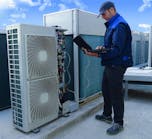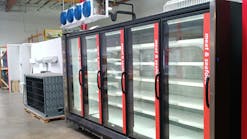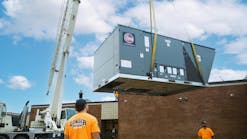Battling every performance issue as it arises can be costly, both in terms of labor and replacement parts, as well as the time when the equipment is underperforming. Routine checkups help keep rooftop systems running smoothly.
By performing appropriate maintenance, problems can be identified and corrected early on, often avoiding the need for major repairs. With that in mind, here are some basic steps to follow when performing scheduled maintenance on rooftop units.
Check for Power
Begin by making sure the unit has power. If the unit has power, look for any service lights or faults codes. In most cases turning off the main power to the unit, then turning it back on will reset the unit control board and the fault code may be lost. These codes may be displayed on the unit itself (viewable through a small sight-glass near the electrical service panel) or on the thermostat.
Adjust the temperature set-point on the thermostat and listen for a clicking noise, indicating that the thermostat relays are engaging.
What Do You See?
Next, do a visual check of the unit, looking for oily or greasy areas, as they may signal a refrigerant leak. Look at the condenser and evaporator coils, to see if they need cleaning. Ice on the evaporator may mean a low-refrigerant charge or “low airflow” due to a dirty or too restrictive air filter.
Tighten Electrical Connections
After you have looked for any visual signs of required service, turn off the power to the unit and begin the maintenance process by tightening all electrical connections. Many failures on units are due to loose wiring. Be careful when tightening the electrical connections on the compressor: if they appear damaged or overheated in any way, the terminal connections may be compromised. If the capacitors appear to be deformed (swelled or leaking) consider replacing them, as they may be nearing the end of their life-cycle.
Always Important: Filter Changeout
If the air filter is dirty, replace it with one the correct size—check to see that the physical size and performance (pressure drop) of the air filter matches the required airflow of the unit. Also check the indoor fan—if the fan is using a typical indoor centrifugal fan assembly, something as small as 1⁄16 inch of dirt on the blades can impact the airflow capability of the fan as much as 10–15 percent.
Coil Cleaning
Cleaning the evaporator coil can be a challenge. If the air filter is doing its job, the indoor coil should not be very dirty. If possible, use compressed air to clean the coil, being careful not to bend the fins of the coil. If water must be used, be careful that the water does not overflow from the drain pan and that the water pressure is not too high as that may force the water into the ductwork. If the unit has a TXV, make sure the sensing bulb strap is tight and properly insulated.
If the condenser coil needs to be cleaned, check to see if the coil design has multiple rows—it may need to be separated in order to be cleaned properly. Check with the OEM’s service manual, to properly clean multiple-row coils as not following the proper washing procedure may push any debris to the second row of the coil, further clogging the coil. Use an appropriate coil cleaner that will not harm the coil. Be careful not to bend the fins of the coil if you are using high water pressure as bent fins will negatively impact the coil’s performance. While working in the condenser area, verify the that fan blades are properly located within the fan housing orifice, as this can impact performance by as much as 10 percent.
Check for Refrigerant Leaks
Before restarting the unit, use a refrigerant leak detector or sniffer to verify that there are no leaks within the unit. Restart the unit and operate the unit in cooling mode, verifying the refrigerant charge by checking subcooling (TXV) or superheat (fixed orifice). If you have completed all of the preventative maintenance steps mentioned above and the refrigerant operating pressures are not within the OEM’s specified range, use the OEM’s troubleshooting guide or download an air conditioning app to help pinpoint the issue.
By following these basic steps while performing maintenance, any rooftop system will perform better and for longer than without it.
Sankar Padhmanabhan is an Application Specialist for Danfoss. Jeff Warther is Manager of Segment Marketing, Air-Conditioning and Commercial Refrigeration, for Danfoss North America.








